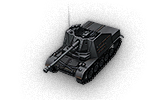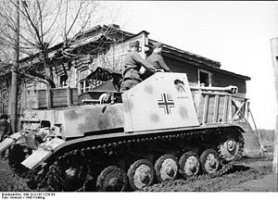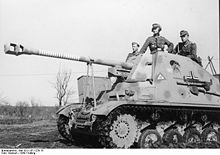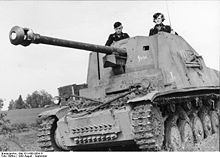Marder II
G20_Marder_II (Stock)
| 42000 가격 |
| 165 내구력 |
| 10.94 / 11 kg중량 |
- 지휘관
| 35/14.5/14.5차체 장갑(정면/측면/후면, mm) |
| 8/0/4포탑 장갑(정면/측면/후면, mm) |
| 130 마력엔진 출력 |
| 40 km/h최대 속력 |
| 34 도/초회전 속도 |
| 115 기본 포탄 공격력 |
| 96 mm기본 포탄 관통력 |
| 5 재장전 시간 |
| 44 도/초포탑 회전 속도 |
| 360 m관측 범위 |
| 265 m통신 범위 |

The Marder II is a German Tier III Tank Destroyer.
The Marder II was developed in response to Germany's first encounters with the T-34 and KV tanks that the Soviet Union fielded in the early stages of the German invasion of Russia. The Marder II was converted from existing Panzer II chassis, with a total of 852 produced between early 1942 and early 1944.
Boasting great penetration and damage with it's guns at the expense of armor and accuracy, the Marder II can be a devastating force if it's strengths can be exploited and weaknesses minimized. With stronger engines and a more damaging top gun than the Panzerjäger I, the Marder II is a decent tank to play whilst heading further up the tank destroyer line.
The Marder II leads to the Tier IV Hetzer.
Compatible Equipment
Compatible Consumables
Player Opinion
Pros and Cons
Pros:
- Excellent Camouflage values
- Excellent Gun Traverse Arc
- Good Gun Depression
- Good Alpha Damage and Damage-per-Minute(DPM) for its tier
- Good Penetration
Cons:
- Terrible and disproportionate Aim Time for all guns, on a level similar to high tier vehicles (typically Heavies and Russian tanks)
- Some of the worst "Shot Dispersion" factors of all vehicles (excluding Artillery) in the game
- Enormous reticle bloom
- The above items together, creates very sub-par accuracy for a Tank Destroyer
- Virtually no armor, typical of lower tier Tank Destroyers
Performance
It is ill-advised to engage in close quarters as its low HP, poor armor, poor track traverse, and horrible movement accuracy will often result in a quick death. Keep in mind that the tank's open-top crew compartment has virtually no armor, making it extremely vulnerable to howitzers, High Explosive shells, autocannons and semi-automatic cannons.
The key to playing the Marder II effectively is to remain hidden and behind the main lines, being patient and working with the horrible Aim Time and reticle bloom of the guns. Get behind bushes and let the multitude of quick Light and Medium tanks in this tier range, do the spotting for you. Exposure is tantamount to death, as you have neither the speed and mobility, nor the armor and HP to escape relatively unscathed from enemy fire.
To maximize your performance in the tank, the Camouflage Net, Binocular Telescope, and Gun Laying Drive (GLD) Equipment will greatly help you in keeping hidden, allowing you to see far, and helping with the horrible Aim Time.
Historical Info
History
During the very first days of Operation Barbarossa, the invasion of the Soviet Union, the Germans were shocked to encounter Soviet T-34 medium tanks and KV heavy tanks. Although the Wehrmacht succeeded in most operations due to superior tactics, morale, and supply, it had few anti-tank weapons capable of successfully engaging these vehicles at normal ranges. An urgent need arose for a more mobile and powerful anti-tank weapon than the existing towed anti-tank guns or tank destroyers like the Panzerjäger I.
Among a series of solutions, it was decided to use light tanks like the Panzer II and captured vehicles like the Lorraine Schlepper as the basis for makeshift tank destroyers. The result was the Marder series, which were armed with either the new 7.5 cm Pak 40 anti-tank guns or captured Soviet 7.62 cm F-22 Model 1936 field guns, large numbers of which had been acquired early in the war.
Production
The Marder II came in two major versions. The first version Marder II (Sd.Kfz. 132) was based on the light Panzer II Ausf. D/E and Flammpanzer II chassis with Christie suspension. It was armed with captured Soviet 7.62 cm guns, re-chambered to accept German 7.5 cm Pak 40 ammunition, which improved its penetrative capabilities. These early Marder IIs had a very high silhouette (2.60 m high), thin armor of only 30 mm (front) and 10 to 15 mm (sides). There was no armour on the top or rear, leaving the crew with very little protection. Alkett and Wegmann produced 201 Marder II (Sd. Kfz. 132) from early 1942 to early 1943.
The second version Marder II (Sd.Kfz. 131) was based on Panzer II Ausf. A to C removed from active service but later also newly produced Ausf. F chassis were used. This Marder II had a redesigned (widened) fighting compartment and used the German 75 mm Pak 40 anti-tank gun. The silhouette was lowered by about 40 cm to 2.20 m, but the armor was thin and the compartment was open to the top and rear, as in Sd. Kfz. 132. FAMO, MAN and Daimler-Benz produced 576 Marder II (Sd.Kfz. 131) conversions from June 1942 to Mid 1943. 75 more were converted (probably by FAMO only) from mid 1943 to early 1944 when the last Panzer IIs were taken out of active service.
Combat history
The various Marder IIs fought on all fronts of the war, mainly at the Eastern Front.
The Marder IIs were used by the Panzerjäger Abteilungen of the Panzer divisions of both the Wehrmacht and the Waffen SS, as well as several Luftwaffe units.
The Marder's weaknesses were mainly related to survivability. The combination of a high silhouette and open-top fighting compartment made them vulnerable to indirect artillery fire, shrapnel, and grenades. The armor was also quite thin, making them vulnerable to enemy tanks or infantry.
The Marders were not assault vehicles or tank substitutes; the open top meant that operations in urban areas or other close-combat situations were very risky. They were best employed in defensive or overwatch roles. Despite their weaknesses they were much more effective than the towed antitank guns they replaced.
Historical Gallery
Sources and External Links
| Light Tanks | |
| Medium Tanks | |
| Heavy Tanks | |
| Tank Destroyers | |
| Self-Propelled Artillery |
| USA | |
| UK | |
| Germany | |
| USSR | |
| China | |
| Japan |


